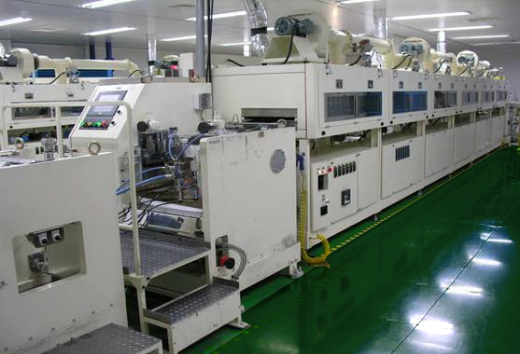Լոկոմոտիվների մեկնարկային մարտկոցների գործարան. Էլեկտրաէներգիայի աղբյուր գնացքների արդյունավետ աշխատանքի համար
Introduction
The locomotive starter battery is a vital component in the operation of trains. It provides the initial power required to start the locomotive engine and helps in the efficient operation of the train. In this article, we will discuss the importance of the locomotive starter battery, its components, types, and maintenance.
Importance of Locomotive Starter Battery
The locomotive starter battery plays a crucial role in the operation of trains. It provides the necessary power to start the engine and helps in powering the various electrical systems in the locomotive. Without a reliable starter battery, the train will not be able to start, and its operations will be disrupted.
Components of Locomotive Starter Battery
The locomotive starter battery comprises several components, including the battery casing, electrolyte, positive and negative plates, separators, and terminal posts. The battery casing is made of high-strength plastic or rubber material that protects the internal components from external damages. The electrolyte is a mixture of water and sulfuric acid, which provides the necessary chemical reaction for the battery\’s operation. The positive and negative plates are made of lead and lead oxide, respectively, and are immersed in the electrolyte. The separators are thin layers of material that prevent the positive and negative plates from touching each other. The terminal posts are the connections that allow the battery to be connected to the electrical system of the train.
Types of Locomotive Starter Battery
There are two main types of locomotive starter batteries, namely lead-acid and nickel-cadmium batteries. The lead-acid battery is the most common type and is used in most locomotive applications. It is relatively cheap and provides high power output. The nickel-cadmium battery, on the other hand, is more expensive but provides better performance and longer life span.

Maintenance of Locomotive Starter Battery
Proper maintenance of the locomotive starter battery is essential to ensure its longevity and reliability. The battery should be regularly checked for its voltage, specific gravity, and electrolyte level. The terminals should also be cleaned and tightened to ensure a firm connection. The battery should be charged regularly to prevent sulfation, which can damage the battery over time.
Եզրակացություն
In conclusion, the locomotive starter battery is a critical component in the operation of trains. It provides the initial power required to start the engine and powers various electrical systems in the locomotive. Proper maintenance of the battery is essential to ensure its longevity and reliability. The lead-acid and nickel-cadmium batteries are the two main types of locomotive starter batteries available in the market.
-
 Introduction In today's rapidly evolving technological landscape, the demand for high-performance, long-lasting batteries is at an all-time high. From electric vehicles to renewable energy storage systems, the need for efficient charging solutions has become paramount. This article introduces the High-Efficiency 48V LiFePO4 Battery Charger, a cutting-edge power solution that offers optimal performance and durability. The Importance of High Efficiency...Կարդալ ավելին
Introduction In today's rapidly evolving technological landscape, the demand for high-performance, long-lasting batteries is at an all-time high. From electric vehicles to renewable energy storage systems, the need for efficient charging solutions has become paramount. This article introduces the High-Efficiency 48V LiFePO4 Battery Charger, a cutting-edge power solution that offers optimal performance and durability. The Importance of High Efficiency...Կարդալ ավելին -
 Introduction As the world strives towards a more sustainable future, the automotive industry is witnessing a paradigm shift from traditional combustion engines to electric vehicles (EVs). One key component that has been a game-changer in this transition is the lithium van battery. This revolutionary advancement has transformed the EV landscape by providing superior performance, longer range, and faster charging...Կարդալ ավելին
Introduction As the world strives towards a more sustainable future, the automotive industry is witnessing a paradigm shift from traditional combustion engines to electric vehicles (EVs). One key component that has been a game-changer in this transition is the lithium van battery. This revolutionary advancement has transformed the EV landscape by providing superior performance, longer range, and faster charging...Կարդալ ավելին -
 In the industrial sector, efficient energy use is key to driving modernization. In this era of high efficiency, Industrial Power Products Batteries are becoming an important force leading the industrial energy revolution with their excellent performance and wide range of applications. They not only provide stable and reliable power support for industrial equipment, but also show great potential in energy...Կարդալ ավելին
In the industrial sector, efficient energy use is key to driving modernization. In this era of high efficiency, Industrial Power Products Batteries are becoming an important force leading the industrial energy revolution with their excellent performance and wide range of applications. They not only provide stable and reliable power support for industrial equipment, but also show great potential in energy...Կարդալ ավելին -
 Introduction: A boating adventure can be an exhilarating experience for many people. Whether it is sailing on calm waters or enjoying the thrill of water sports, boats provide a unique opportunity to connect with nature and unwind from the stresses of everyday life. However, to ensure that your boat operates smoothly and reliably, it is crucial to have a...Կարդալ ավելին
Introduction: A boating adventure can be an exhilarating experience for many people. Whether it is sailing on calm waters or enjoying the thrill of water sports, boats provide a unique opportunity to connect with nature and unwind from the stresses of everyday life. However, to ensure that your boat operates smoothly and reliably, it is crucial to have a...Կարդալ ավելին -
 Introduction: In recent years, lithium starter batteries have emerged as a popular and efficient alternative to traditional lead-acid batteries. These lightweight batteries are designed to provide reliable power for a wide range of applications, including automobiles, motorcycles, and marine vessels. In this article, we explore the advantages of lithium starter batteries over traditional lead-acid batteries and why they are...Կարդալ ավելին
Introduction: In recent years, lithium starter batteries have emerged as a popular and efficient alternative to traditional lead-acid batteries. These lightweight batteries are designed to provide reliable power for a wide range of applications, including automobiles, motorcycles, and marine vessels. In this article, we explore the advantages of lithium starter batteries over traditional lead-acid batteries and why they are...Կարդալ ավելին -
 Ներկայացնել Ժամանակակից տեխնոլոգիաներով առաջնորդվող աշխարհում հուսալի և արդյունավետ էներգիայի լուծումների պահանջարկը առաջնային է տարբեր արդյունաբերական ոլորտներում: Արդյունաբերական էներգիայի արտադրանքի մարտկոցները հայտնվում են որպես անհայտ հերոսներ՝ առաջարկելով էներգիայի ամուր և հուսալի աղբյուր, որը թույլ է տալիս անխափան աշխատել կարևորագույն գործողությունները: Այս մասնագիտացված մարտկոցները, որոնք նախատեսված են արդյունաբերական կիրառությունների համար, հայտնի են դարձել իրենց բացառիկ հնարավորություններով՝ մատուցելու...Կարդալ ավելին
Ներկայացնել Ժամանակակից տեխնոլոգիաներով առաջնորդվող աշխարհում հուսալի և արդյունավետ էներգիայի լուծումների պահանջարկը առաջնային է տարբեր արդյունաբերական ոլորտներում: Արդյունաբերական էներգիայի արտադրանքի մարտկոցները հայտնվում են որպես անհայտ հերոսներ՝ առաջարկելով էներգիայի ամուր և հուսալի աղբյուր, որը թույլ է տալիս անխափան աշխատել կարևորագույն գործողությունները: Այս մասնագիտացված մարտկոցները, որոնք նախատեսված են արդյունաբերական կիրառությունների համար, հայտնի են դարձել իրենց բացառիկ հնարավորություններով՝ մատուցելու...Կարդալ ավելին -
 Lithium Iron Phosphate Like other batteries, LiFePO4 batteries are made from electricity-generating electrochemical cells that power electrical devices. A LiFePO4 battery consists of a positive electrode, positive electrode, separator, electrolyte, positive and negative current collectors. The positive terminal of the battery is called the cathode and the negative terminal is called the anode. Anode terminal as Li-ion source. The electrolyte...Կարդալ ավելին
Lithium Iron Phosphate Like other batteries, LiFePO4 batteries are made from electricity-generating electrochemical cells that power electrical devices. A LiFePO4 battery consists of a positive electrode, positive electrode, separator, electrolyte, positive and negative current collectors. The positive terminal of the battery is called the cathode and the negative terminal is called the anode. Anode terminal as Li-ion source. The electrolyte...Կարդալ ավելին

